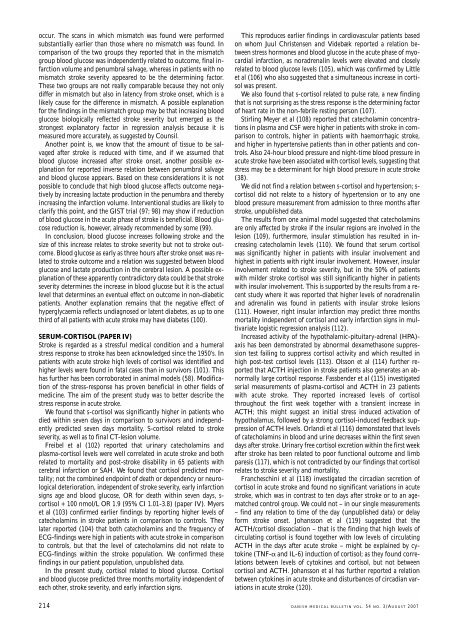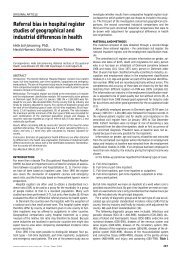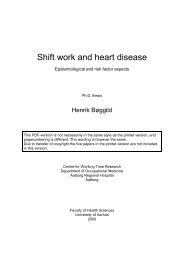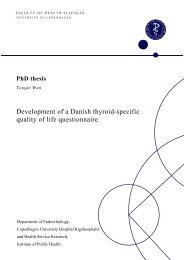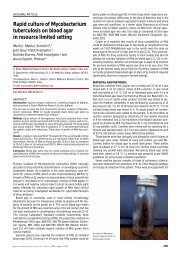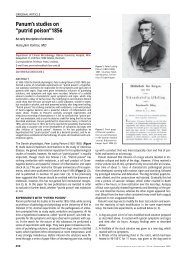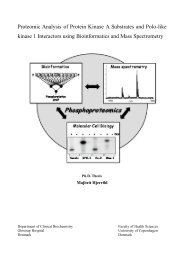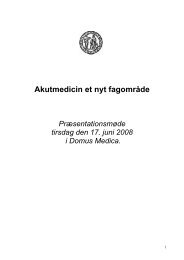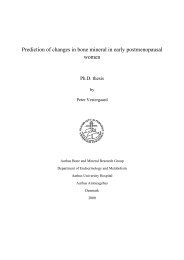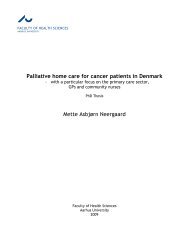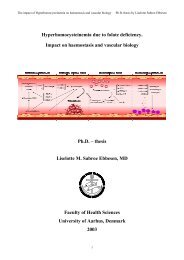Acute stroke â a dynamic process - Danish Medical Bulletin
Acute stroke â a dynamic process - Danish Medical Bulletin
Acute stroke â a dynamic process - Danish Medical Bulletin
You also want an ePaper? Increase the reach of your titles
YUMPU automatically turns print PDFs into web optimized ePapers that Google loves.
occur. The scans in which mismatch was found were performed<br />
substantially earlier than those where no mismatch was found. In<br />
comparison of the two groups they reported that in the mismatch<br />
group blood glucose was independently related to outcome, final infarction<br />
volume and penumbral salvage, whereas in patients with no<br />
mismatch <strong>stroke</strong> severity appeared to be the determining factor.<br />
These two groups are not really comparable because they not only<br />
differ in mismatch but also in latency from <strong>stroke</strong> onset, which is a<br />
likely cause for the difference in mismatch. A possible explanation<br />
for the findings in the mismatch group may be that increasing blood<br />
glucose biologically reflected <strong>stroke</strong> severity but emerged as the<br />
strongest explanatory factor in regression analysis because it is<br />
measured more accurately, as suggested by Counsil.<br />
Another point is, we know that the amount of tissue to be salvaged<br />
after <strong>stroke</strong> is reduced with time, and if we assumed that<br />
blood glucose increased after <strong>stroke</strong> onset, another possible explanation<br />
for reported inverse relation between penumbral salvage<br />
and blood glucose appears. Based on these considerations it is not<br />
possible to conclude that high blood glucose affects outcome negatively<br />
by increasing lactate production in the penumbra and thereby<br />
increasing the infarction volume. Interventional studies are likely to<br />
clarify this point, and the GIST trial (97; 98) may show if reduction<br />
of blood glucose in the acute phase of <strong>stroke</strong> is beneficial. Blood glucose<br />
reduction is, however, already recommended by some (99).<br />
In conclusion, blood glucose increases following <strong>stroke</strong> and the<br />
size of this increase relates to <strong>stroke</strong> severity but not to <strong>stroke</strong> outcome.<br />
Blood glucose as early as three hours after <strong>stroke</strong> onset was related<br />
to <strong>stroke</strong> outcome and a relation was suggested between blood<br />
glucose and lactate production in the cerebral lesion. A possible explanation<br />
of these apparently contradictory data could be that <strong>stroke</strong><br />
severity determines the increase in blood glucose but it is the actual<br />
level that determines an eventual effect on outcome in non-diabetic<br />
patients. Another explanation remains that the negative effect of<br />
hyperglycaemia reflects undiagnosed or latent diabetes, as up to one<br />
third of all patients with acute <strong>stroke</strong> may have diabetes (100).<br />
SERUM-CORTISOL (PAPER IV)<br />
Stroke is regarded as a stressful medical condition and a humeral<br />
stress response to <strong>stroke</strong> has been acknowledged since the 1950’s. In<br />
patients with acute <strong>stroke</strong> high levels of cortisol was identified and<br />
higher levels were found in fatal cases than in survivors (101). This<br />
has further has been corroborated in animal models (58). Modification<br />
of the stress-response has proven beneficial in other fields of<br />
medicine. The aim of the present study was to better describe the<br />
stress response in acute <strong>stroke</strong>.<br />
We found that s-cortisol was significantly higher in patients who<br />
died within seven days in comparison to survivors and independently<br />
predicted seven days mortality. S-cortisol related to <strong>stroke</strong><br />
severity, as well as to final CT-lesion volume.<br />
Freibel et al (102) reported that urinary catecholamins and<br />
plasma-cortisol levels were well correlated in acute <strong>stroke</strong> and both<br />
related to mortality and post-<strong>stroke</strong> disability in 65 patients with<br />
cerebral infarction or SAH. We found that cortisol predicted mortality;<br />
not the combined endpoint of death or dependency or neurological<br />
deterioration, independent of <strong>stroke</strong> severity, early infarction<br />
signs age and blood glucose, OR for death within seven days, s-<br />
cortisol + 100 nmol/L OR 1.9 (95% CI 1.01-3.8) (paper IV). Myers<br />
et al (103) confirmed earlier findings by reporting higher levels of<br />
catecholamins in <strong>stroke</strong> patients in comparison to controls. They<br />
later reported (104) that both catecholamins and the frequency of<br />
ECG-findings were high in patients with acute <strong>stroke</strong> in comparison<br />
to controls, but that the level of catecholamins did not relate to<br />
ECG-findings within the <strong>stroke</strong> population. We confirmed these<br />
findings in our patient population, unpublished data.<br />
In the present study, cortisol related to blood glucose. Cortisol<br />
and blood glucose predicted three months mortality independent of<br />
each other, <strong>stroke</strong> severity, and early infarction signs.<br />
This reproduces earlier findings in cardiovascular patients based<br />
on whom Juul Christensen and Videbæk reported a relation between<br />
stress hormones and blood glucose in the acute phase of myocardial<br />
infarction, as noradrenalin levels were elevated and closely<br />
related to blood glucose levels (105), which was confirmed by Little<br />
et al (106) who also suggested that a simultaneous increase in cortisol<br />
was present.<br />
We also found that s-cortisol related to pulse rate, a new finding<br />
that is not surprising as the stress response is the determining factor<br />
of heart rate in the non-febrile resting person (107).<br />
Stirling Meyer et al (108) reported that catecholamin concentrations<br />
in plasma and CSF were higher in patients with <strong>stroke</strong> in comparison<br />
to controls, higher in patients with haemorrhagic <strong>stroke</strong>,<br />
and higher in hypertensive patients than in other patients and controls.<br />
Also 24-hour blood pressure and night-time blood pressure in<br />
acute <strong>stroke</strong> have been associated with cortisol levels, suggesting that<br />
stress may be a determinant for high blood pressure in acute <strong>stroke</strong><br />
(38).<br />
We did not find a relation between s-cortisol and hypertension; s-<br />
cortisol did not relate to a history of hypertension or to any one<br />
blood pressure measurement from admission to three months after<br />
<strong>stroke</strong>, unpublished data.<br />
The results from one animal model suggested that catecholamins<br />
are only affected by <strong>stroke</strong> if the insular regions are involved in the<br />
lesion (109), furthermore, insular stimulation has resulted in increasing<br />
catecholamin levels (110). We found that serum cortisol<br />
was significantly higher in patients with insular involvement and<br />
highest in patients with right insular involvement. However, insular<br />
involvement related to <strong>stroke</strong> severity, but in the 50% of patients<br />
with milder <strong>stroke</strong> cortisol was still significantly higher in patients<br />
with insular involvement. This is supported by the results from a recent<br />
study where it was reported that higher levels of noradrenalin<br />
and adrenalin was found in patients with insular <strong>stroke</strong> lesions<br />
(111). However, right insular infarction may predict three months<br />
mortality independent of cortisol and early infarction signs in multivariate<br />
logistic regression analysis (112).<br />
Increased activity of the hypothalamic-pituitary-adrenal (HPA)-<br />
axis has been demonstrated by abnormal dexamethasone suppression<br />
test failing to suppress cortisol activity and which resulted in<br />
high post-test cortisol levels (113). Olsson et al (114) further reported<br />
that ACTH injection in <strong>stroke</strong> patients also generates an abnormally<br />
large cortisol response. Fassbender et al (115) investigated<br />
serial measurements of plasma-cortisol and ACTH in 23 patients<br />
with acute <strong>stroke</strong>. They reported increased levels of cortisol<br />
throughout the first week together with a transient increase in<br />
ACTH; this might suggest an initial stress induced activation of<br />
hypothalamus, followed by a strong cortisol-induced feedback suppression<br />
of ACTH levels. Orlandi et al (116) demonstated that levels<br />
of catecholamins in blood and urine decreases within the first seven<br />
days after <strong>stroke</strong>. Urinary free cortisol excretion within the first week<br />
after <strong>stroke</strong> has been related to poor functional outcome and limb<br />
paresis (117), which is not contradicted by our findings that cortisol<br />
relates to <strong>stroke</strong> severity and mortality.<br />
Francheschini et al (118) investigated the circadian secretion of<br />
cortisol in acute <strong>stroke</strong> and found no significant variations in acute<br />
<strong>stroke</strong>, which was in contrast to ten days after <strong>stroke</strong> or to an agematched<br />
control group. We could not – in our single measurements<br />
– find any relation to time of the day (unpublished data) or delay<br />
form <strong>stroke</strong> onset. Johansson et al (119) suggested that the<br />
ACTH/cortisol dissociation – that is the finding that high levels of<br />
circulating cortisol is found together with low levels of circulating<br />
ACTH in the days after acute <strong>stroke</strong> – might be explained by cytokine<br />
(TNF-α and IL-6) induction of cortisol; as they found correlations<br />
between levels of cytokines and cortisol, but not between<br />
cortisol and ACTH. Johansson et al has further reported a relation<br />
between cytokines in acute <strong>stroke</strong> and disturbances of circadian variations<br />
in acute <strong>stroke</strong> (120).<br />
214 DANISH MEDICAL BULLETIN VOL. 54 NO. 3/AUGUST 2007


